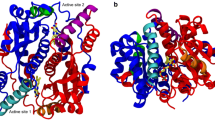Summary
The inhibition of Pneumocystis carinii dihydrofolate reductase (DHFR) continues to be the major treatment strategy for P. carinii pneumonia (PCP). The design of new anti-pneumocystis agents would be significantly enhanced by the availability of a 3D model of the methotrexate (MTX) binding site of the P. carinii DHFR. However, an X-ray crystal structure of the P. carinii DHFR is not yet available. Alignment of the amino acid sequences of P. carinii and Lactobacillus casei DHFRs indicates that the two proteins show approximately 80% homology among MTX binding-site residues. This high level of homology suggests that the L. casei DHFR MTX binding-site structure could serve as a structural template in developing a model of the P. carinii DHFR MTX binding site. Therefore, the X-ray crystal structure of L. casei DHFR was used to develop a 3D model of the methotrexate binding site of P. carinii DHFR. The molecular modeling and dynamics software QUANTA/CHARMm was used. Amino acid residue mutations and deletions were performed using QUANTA and macromolecular minimizations were achieved with CHARMm. The MTX binding-site residues of L. casei DHFR were mutated to the corresponding residues of the P. carinii DHFR sequence. The resulting structure was extensively minimized. The resulting P. carinii MTX binding-site model showed significant differences in hydrogen-bonding patterns from the L. casei MTX binding site. Also, the P. carinii site is more hydrophobic than the corresponding L. casei site. Analysis of atom-to-atom close contacts between methotrexate and protein binding-site residues indicates that the P. carinii MTX binding-site complex is primarily stabilized by hydrophobic interactions, while the L. casei complex is mostly stabilized by electrostatic interactions. The model is consistent with the observed increased sensitivity of P. carinii DHFR to lipid-soluble inhibitors and provides a rational basis for the design of new anti-pneumocystis agents.
Similar content being viewed by others
References
Allegra C.J., Kovacs J.A., Drake J.C., Swan J.C., Chabner B.A. and Masur H., J. Exp. Med., 165 (1987) 926.
Ansden G.W., Kowalsky S.F. and Morse G.D., Annu. Pharmacother., 26 (1992) 218.
Kovacs J.A., Allegra C.J., Beaver J., Boarman D., Lewis M., Parrill J.E., Chabner B. and Masur H., J. Infect. Dis., 160 (1989) 312.
Broughton M.C. and Queener S.F., Antimicrob. Agents Chemother., 35 (1991) 1348.
Queener S.F., J. Protozool., 38 (1991) 1545.
Edman J.C., Edman U., Cao M., Lundgran B., Kovacs J.A. and Santi D.V., Proc. Natl. Acad. Sci. USA, 86 (1989) 8625.
Kovacs J.A., Allegra C.J. and Masur H., Exp. Parasitol., 71 (1990) 60.
Matthews D.A., Alden R.A., Bolin J.T., Filman D.J., Freer S.T., Hamlin R., Hol W.G.J., Kisliuk R.L., Pastore E.J., Plante L.T., Xuong N.-H. and Kraut J., J. Biol. Chem., 253 (1978) 6946.
Author information
Authors and Affiliations
Rights and permissions
About this article
Cite this article
Southerland, W.M. A molecular model of the folate binding site of Pneumocystis carinii dihydrofolate reductase. J Computer-Aided Mol Des 8, 113–122 (1994). https://doi.org/10.1007/BF00119862
Received:
Accepted:
Issue Date:
DOI: https://doi.org/10.1007/BF00119862




